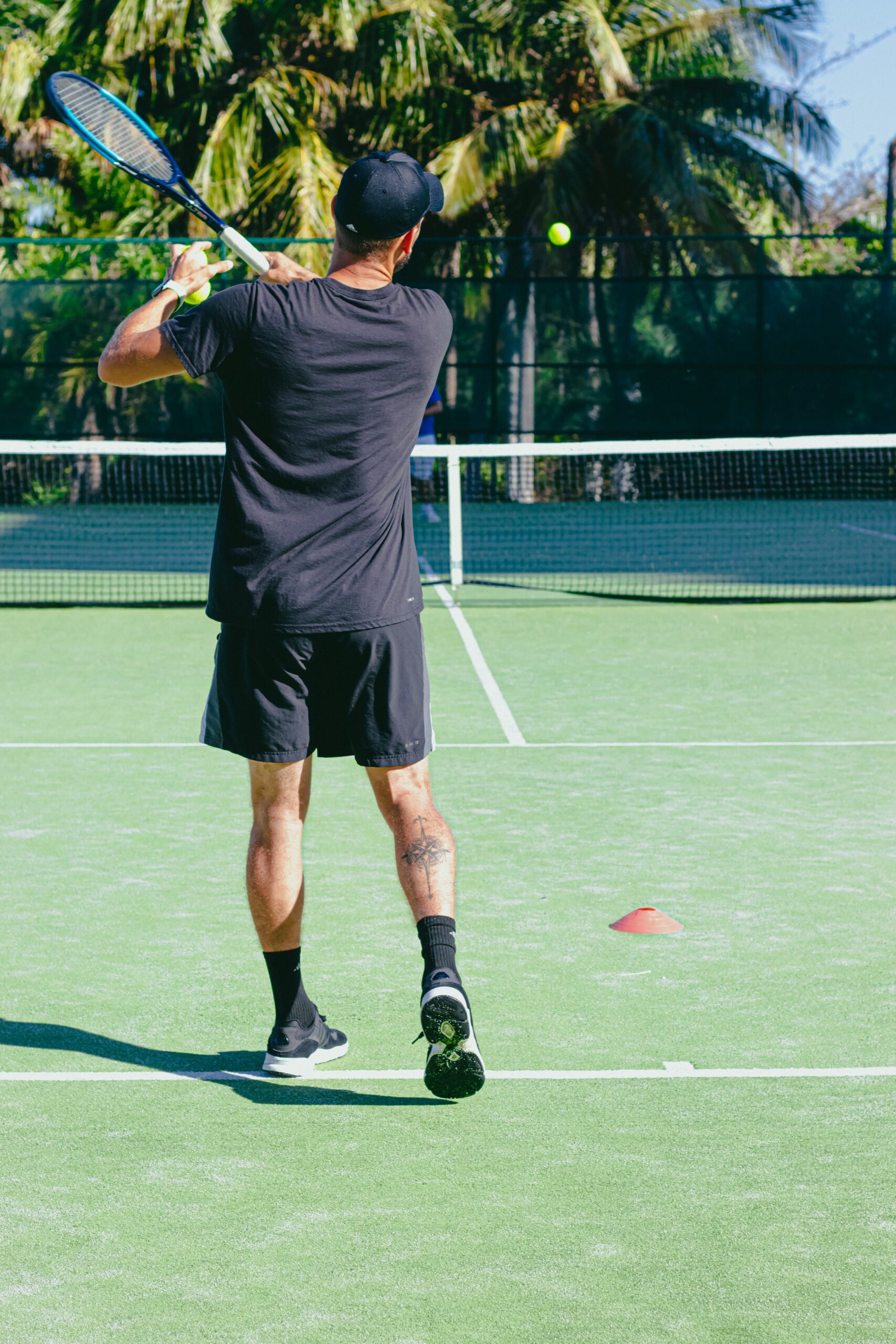Deciding whether your child should learn to play tennis with two hands or a one-handed backhand can be a tough choice. Both techniques have their advantages and disadvantages, and the decision ultimately relies on factors such as your child’s age, physical abilities, and personal preference. In this article, we will explore the pros and cons of each approach, helping you make an informed decision regarding which style is best suited for your child’s development and enjoyment in the game of tennis.

Benefits of a Two-Handed Backhand
Increased power
One of the major benefits of using a two-handed backhand is the increased power it provides. By using both hands on the grip, you are able to generate more force and transfer it into the shot. This allows you to hit the ball with greater speed and drive it deeper into the court.
Better control
Another advantage of the two-handed backhand is the improved control it offers. With two hands on the grip, you have more stability and balance, which allows for better shot placement. You can easily adjust the angle and direction of your shots, giving you greater precision and accuracy.
Easier to learn
For beginners, the two-handed backhand is often easier to learn compared to the one-handed backhand. Using both hands on the grip provides more support and stability, making it easier to execute the proper technique. This can help beginners develop a solid foundation and build confidence in their game.
Versatility
The two-handed backhand also offers greater versatility on the court. With two hands on the grip, you can generate topspin more effectively, allowing you to hit higher bouncing shots and effectively counter your opponent’s spin. Additionally, the two-handed backhand provides good defensive capabilities, as it allows for quick and controlled block shots.
Benefits of a One-Handed Backhand
More reach
The one-handed backhand provides players with increased reach compared to the two-handed backhand. By using just one hand on the grip, players are able to stretch and extend their shots more effectively, reaching balls that would otherwise be out of reach. This added reach can be especially advantageous when facing wide shots or trying to hit angles.
Better slice shots
One of the standout benefits of the one-handed backhand is its ability to produce effective slice shots. With only one hand on the grip, players have more flexibility and control over the racket head, allowing them to generate slice spin and produce low, skidding shots. This shot can be particularly valuable on faster surfaces, as it keeps the ball low and difficult for opponents to handle.
Adds variety to the game
Using a one-handed backhand adds variety to a player’s game. This shot provides a different look and feel compared to the more common two-handed backhand, which can surprise opponents and keep them off balance. It allows players to mix up their shots, creating unpredictability and making it harder for their opponents to anticipate their next move.
Considerations for Two-Handed Backhand
Strength and coordination requirements
While the two-handed backhand is generally easier to learn, it does require sufficient strength and coordination. The use of both hands on the grip requires players to have strong core muscles and good hand-eye coordination to execute the technique effectively. Building strength and coordination through practice and conditioning exercises is essential for maximizing the potential of the two-handed backhand.
Limited reach
Compared to the one-handed backhand, the two-handed backhand has a more limited reach. Using both hands on the grip restricts the extension and flexibility of the shot, making it more challenging to reach balls that are far away or out of the player’s reach. This limitation can be a disadvantage when facing wide shots or trying to play defensive shots out of the reach of the opponent.
Potential for wrist and elbow injuries
The two-handed backhand can put increased strain on the wrist and elbow, leading to potential injuries. The repetitive motion of hitting with both hands on the grip, especially with incorrect technique or excessive force, can result in strain and overuse injuries. Players should focus on proper form and technique, as well as incorporating appropriate strength and conditioning exercises, to minimize the risk of these injuries.
Difficulty with high balls
One weakness of the two-handed backhand is its difficulty in handling high balls. With both hands on the grip, players may struggle to generate enough upward lift to effectively counter high balls. This can make it challenging to consistently hit high shots with power and control, potentially giving opponents an advantage in rallies.
Considerations for One-Handed Backhand
Technical demands
The one-handed backhand requires more technical skill and precision compared to the two-handed backhand. Using just one hand on the grip requires players to have excellent body rotation, timing, and racquet control to generate power and control on the shot. Proper technique and extensive practice are necessary to master the one-handed backhand effectively.
Vulnerability to high balls
Due to the nature of the grip and positioning, the one-handed backhand is generally more vulnerable to high balls. The use of one hand on the grip can make it challenging to generate sufficient lift and control on high shots, leading to inconsistencies and potential errors. Players with a one-handed backhand need to work on their footwork and positioning to address this vulnerability and improve their ability to handle high balls effectively.
Less control on volleys
The one-handed backhand can also provide less control on volleys compared to the two-handed backhand. With just one hand on the grip, players may find it more challenging to make quick adjustments and control the racket head while at the net. Proper technique and extensive practice are necessary to ensure that players can effectively execute volleys with a one-handed backhand.
Potential for shoulder injuries
The one-handed backhand can place increased stress on the shoulder joint, potentially leading to injuries. The motion required to generate power and control on the one-handed backhand can put strain on the shoulder, especially if players have poor technique or weak shoulder muscles. Regular strength and mobility exercises are essential for maintaining shoulder health and minimizing the risk of injuries.

Player’s Physical Attributes
Hand dominance
A player’s hand dominance can play a role in determining the appropriate backhand technique. If a player has a strong dominant hand, they may find it more natural and comfortable to use a one-handed backhand. On the other hand, players with equal hand strength or a stronger non-dominant hand may prefer the stability and support provided by a two-handed backhand.
Physical strength
Physical strength is also an important consideration when choosing a backhand technique. Players with good upper body strength may find it easier to generate power and control with a one-handed backhand. On the other hand, players with less upper body strength may benefit from the added support and stability of a two-handed backhand.
Arm length
Arm length can affect the reach and extension of a player’s shots, making it an important factor to consider when choosing a backhand technique. Players with longer arms may find it easier to reach and extend their shots with a one-handed backhand. Conversely, players with shorter arms may prefer the added support and control provided by a two-handed backhand.
Body posture
A player’s body posture and overall physique can also influence their backhand technique. Players with a more upright posture and a strong core may find it easier to maintain balance and stability with a two-handed backhand. On the other hand, players with a more bent or flexible spine may be better suited for the fluid motion and range of motion required for a one-handed backhand.
Player’s Playing Style
Baseline player
For baseline players who prefer to stay behind the baseline and play powerful groundstrokes, the two-handed backhand is often a better fit. The added power and control provided by the two hands on the grip can help generate pace and control on shots, allowing baseline players to dictate play and hit winners from the back of the court.
All-court player
An all-court player who likes to mix up their game and play from all areas of the court can benefit from both backhand techniques. However, the one-handed backhand may offer more versatility and variety. It allows the player to execute slice shots, block shots, and hit angles effectively, adding different dimensions to their game.
Serve and volley player
For players who employ a serve and volley strategy, the one-handed backhand is often favored. The reach and agility provided by the one-handed backhand make it easier to transition to the net quickly and effectively. It also allows for better control on volleys, enabling serve and volley players to finish points at the net with finesse.
Defensive player
A defensive player who relies on counterpunching and retrieving balls can benefit from the added stability and control of the two-handed backhand. The ability to generate topspin and easily adjust the angle and placement of shots can help defensive players turn defense into offense and extend rallies.

Matching Playing Style with Backhand Technique
Baseline player and two-handed backhand
For a baseline player who relies on consistent and powerful groundstrokes, the two-handed backhand is a natural choice. The increased power and control allow them to hit deep and penetrating shots, putting pressure on their opponents and controlling the tempo of the rallies.
All-court player and one-handed backhand
An all-court player who likes to mix up their game and play from all areas of the court may benefit from the versatility offered by the one-handed backhand. The added reach, effective slice shots, and ability to hit angles can keep opponents guessing and give the player an edge in different situations.
Serve and volley player and one-handed backhand
For players who favor a serve and volley style, the one-handed backhand is often the preferred technique. The flexibility and reach it provides make it easier to transition to the net and execute volleys with control and finesse, setting up opportunities to finish points quickly.
Defensive player and two-handed backhand
A defensive player who excels at retrieving shots and extending rallies can benefit from the stability and control offered by the two-handed backhand. The ability to generate topspin and easily adjust shot placement allows defensive players to turn defense into offense and keep opponents on their toes.
Coaching Preference and Expertise
Coach’s personal preference
A coach’s personal preference may influence their recommendation regarding backhand technique. Coaches who have a personal affinity for one technique over the other may be more inclined to teach and develop players using their preferred technique. It is important for coaches to be aware of their biases and ensure that they are providing objective guidance to their players.
Coach’s expertise and experience
A coach’s expertise and experience with different backhand techniques can also impact their recommendation. Coaches who have extensive knowledge and experience in teaching both the one-handed and two-handed backhand can offer more balanced and informed guidance to their players. It is valuable for coaches to have a comprehensive understanding of both techniques to effectively develop players and help them reach their full potential.
Open-mindedness to explore different techniques
A coach’s willingness to explore different backhand techniques is crucial in creating a positive learning environment for players. Being open-minded and adaptable allows coaches to tailor their instruction to the individual needs and preferences of each player. This fosters a sense of trust between coach and player and enables players to embrace different techniques and maximize their skills.
Importance of Early Technique Development
Critical period for skill acquisition
Early technique development in tennis is crucial for long-term skill acquisition. During the formative years, players have a greater ability to absorb and learn new skills and movements. It is important to introduce proper technique from the beginning, as it builds a strong foundation and muscle memory that will benefit players as they progress in their tennis journey.
Long-term development
Developing proper technique early on sets the stage for long-term development and success in tennis. The muscle memory and techniques learned during the early stages become ingrained and more difficult to change or modify later on. By focusing on proper technique from the beginning, players can build a solid foundation and improve their chances of reaching their full potential.
Consistency and muscle memory
Consistency and muscle memory are key components of successful tennis technique. By teaching players the correct technique early on, they can develop muscle memory that allows them to execute shots with consistency and accuracy. Consistent technique not only improves performance but also reduces the risk of injury and increases overall confidence on the court.
The Role of Player’s Motivation
Player’s interest in learning a specific technique
The player’s interest in learning a specific backhand technique should not be overlooked. Players who have a personal preference or passion for one technique over the other may be more motivated to dedicate the time and effort required to master that technique. Engaging players in the decision-making process and considering their preferences can help foster a positive learning environment and maximize their enjoyment of the sport.
Personal goals and aspirations
The player’s personal goals and aspirations can also influence their choice of backhand technique. Players who have specific goals, such as competing at a high level or emulating their favorite professional players, may be driven to learn a particular technique that aligns with those goals. Understanding and supporting the player’s goals can help create a sense of purpose and motivation in their tennis journey.
Enjoyment and passion for the sport
At the core of it all, the player’s enjoyment and passion for the sport should be prioritized. Choosing a backhand technique that the player finds enjoyable and fulfilling can enhance their overall experience on the court. When players are truly passionate about their style of play, they are more likely to put in the time and effort required to develop their skills and achieve their goals.
In conclusion, deciding between a two-handed backhand and a one-handed backhand in tennis involves various considerations. The choice depends on factors such as the player’s physical attributes, playing style, coaching preference, and expertise, as well as the player’s motivation and goals. Both techniques offer unique benefits and challenges, and it is important for players and coaches to carefully evaluate these factors to make an informed decision. Ultimately, the most suitable backhand technique is one that maximizes the player’s strengths and aligns with their individual playing style, giving them the confidence and ability to excel on the court.



